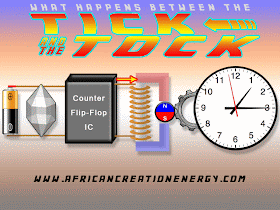In order to know what happens between the tick and the tock, we must first discover what causes the tick and the tock. So, let us take a peak into the mechanics of time! The gears, circuitry, and components of clockwork are basically: An oscillator to provide a time-base, Two or more clock hands, An enumerated dial on the face of the clock, and, Gears to transfer the motion of the oscillator to the hands on the dial. In grand-father clocks, the oscillator is a swinging pendulum. In electronic clocks, the oscillator is a "Quartz Crystal." In electronic clocks, electrons flowing from the battery electrify the quartz crystal. When the quartz crystal is electrified, it begins to "Vibrate or Oscillate" due to one of its properties called the "piezoelectric effect." A counter counts the vibrations of the quartz crystal, and then alternates the output to a solenoid coil. As the polarity of the solenoid changes, it causes a small round magnet to rotate. As the magnet rotates, it causes a "Tick," "Tock" sound, and the gears of the clock transfer the motion of the rotating magnet to the hands of the clock. So, what happens between the tick and the tock of time is movement and vibration! On the large scale, the movement and vibration of the pendulum swinging occurs between the tick and the tock on Grandfather clocks. And on the sub-atomic scale, the movement and flow of electrons which cause the oscillation and vibration of a quartz crystal happens between the tick and the tock in electronic clocks. Because the electron is a Fundamental particle of Nature, the movement of this sub-atomic particle is "The First" movement on which the Second of time is based. For more information, check out the book, "The Science of Sciences and The Science in Sciences" available at www.AfricanCreationEnergy.com.
African Creation Energy, Creative Solution-Based Technical Consulting. African Creation Energy is dedicated to the African Scientific, Technological, and Industrial revolution. This blog presents information related to African Science, Math, Engineering, and Technology
Sunday, February 26, 2012
What Happens Between the Tick and the Tock?
In order to know what happens between the tick and the tock, we must first discover what causes the tick and the tock. So, let us take a peak into the mechanics of time! The gears, circuitry, and components of clockwork are basically: An oscillator to provide a time-base, Two or more clock hands, An enumerated dial on the face of the clock, and, Gears to transfer the motion of the oscillator to the hands on the dial. In grand-father clocks, the oscillator is a swinging pendulum. In electronic clocks, the oscillator is a "Quartz Crystal." In electronic clocks, electrons flowing from the battery electrify the quartz crystal. When the quartz crystal is electrified, it begins to "Vibrate or Oscillate" due to one of its properties called the "piezoelectric effect." A counter counts the vibrations of the quartz crystal, and then alternates the output to a solenoid coil. As the polarity of the solenoid changes, it causes a small round magnet to rotate. As the magnet rotates, it causes a "Tick," "Tock" sound, and the gears of the clock transfer the motion of the rotating magnet to the hands of the clock. So, what happens between the tick and the tock of time is movement and vibration! On the large scale, the movement and vibration of the pendulum swinging occurs between the tick and the tock on Grandfather clocks. And on the sub-atomic scale, the movement and flow of electrons which cause the oscillation and vibration of a quartz crystal happens between the tick and the tock in electronic clocks. Because the electron is a Fundamental particle of Nature, the movement of this sub-atomic particle is "The First" movement on which the Second of time is based. For more information, check out the book, "The Science of Sciences and The Science in Sciences" available at www.AfricanCreationEnergy.com.

No comments:
Post a Comment